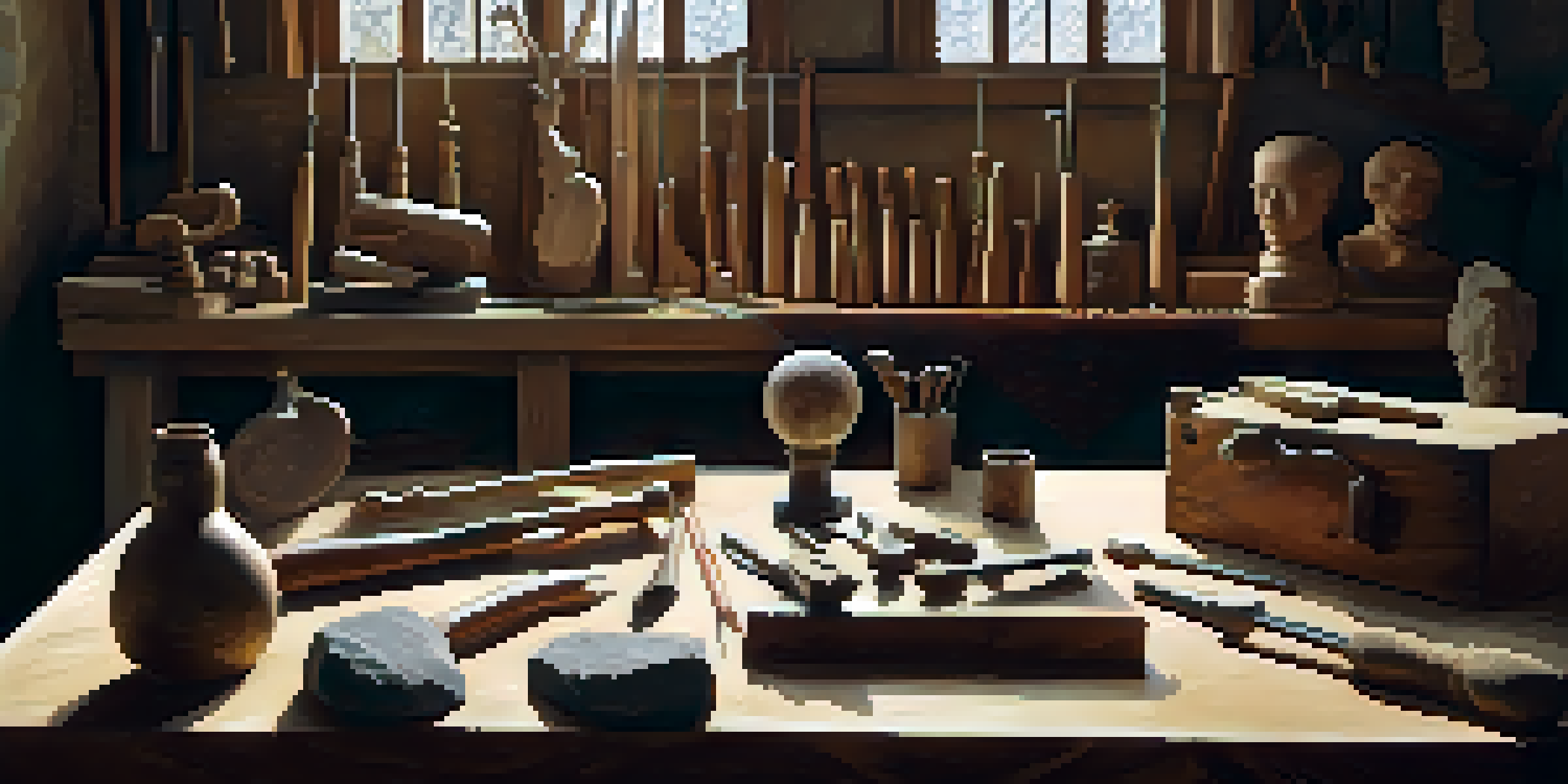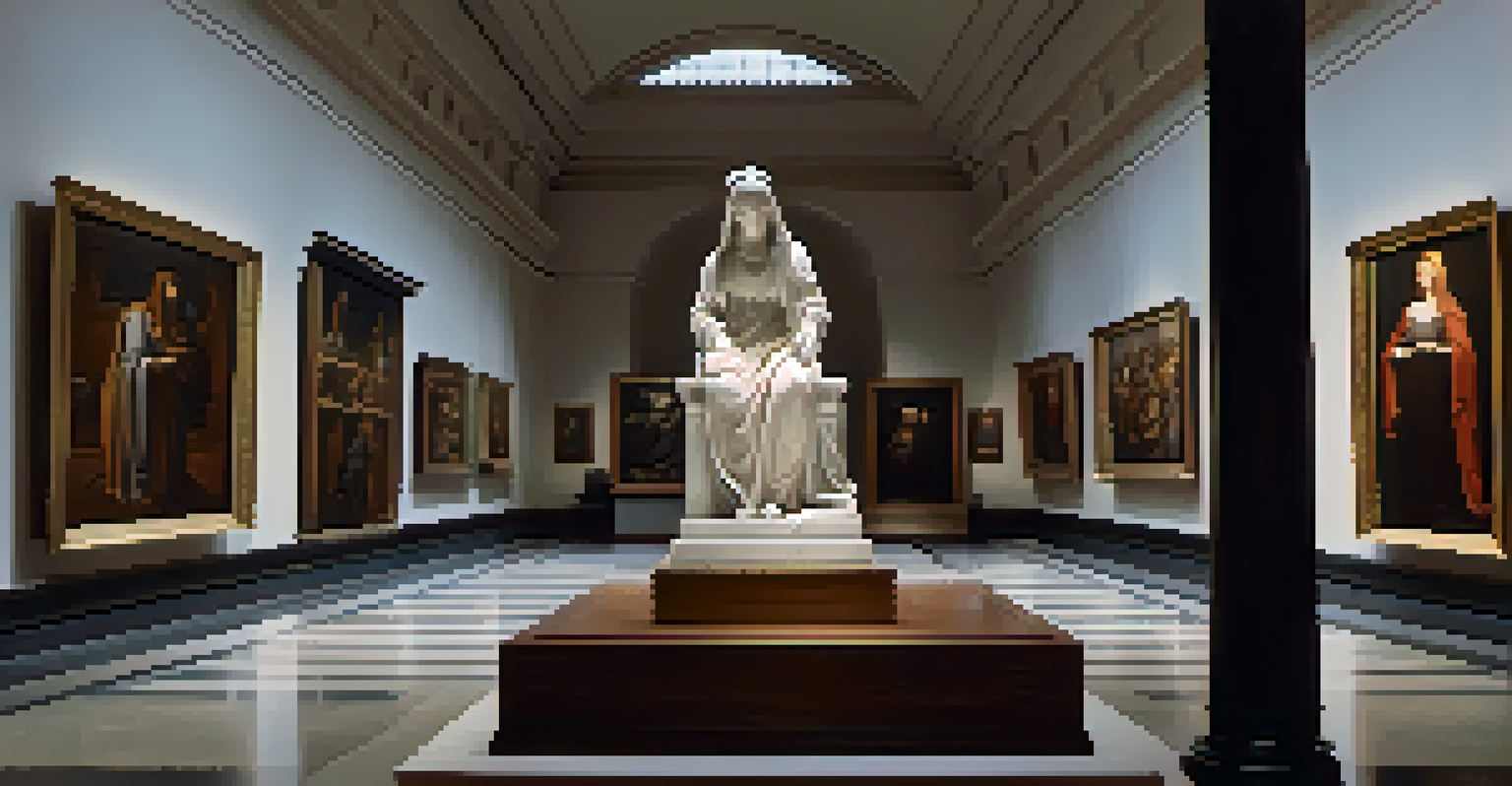The Renaissance of Stone Carving: Donatello's Influence

Understanding the Renaissance and Its Artistic Context
The Renaissance, spanning the 14th to the 17th century, marked a profound rebirth of art and culture in Europe. It was a time when artists sought inspiration from classical antiquity, leading to innovations in techniques and themes. This period was characterized by a shift towards realism, humanism, and the exploration of perspective, all of which would redefine the role of the artist in society.
Art is never finished, only abandoned.
During this vibrant era, stone carving became a significant medium for expressing ideas and emotions. Artists began to experiment with the human form, emphasizing anatomical accuracy and dynamic poses. This newfound focus on realism laid the groundwork for the masterpieces that would emerge, with Donatello being a pivotal figure in this transformation.
As we delve into Donatello's influence, it's essential to recognize how his approach to stone carving encapsulated the spirit of the Renaissance. His work not only reflected the changing artistic landscape but also paved the way for future generations of sculptors.
Donatello: The Sculptor Who Redefined Stone Carving
Donatello, born in Florence around 1386, is often regarded as one of the greatest sculptors of the Renaissance. His innovative techniques and expressive forms breathed new life into stone carving, allowing for more emotional depth and realism. Unlike his predecessors, who often adhered to rigid forms, Donatello embraced a more naturalistic style that captured the human experience.

One of his groundbreaking techniques was the use of contrapposto, a pose where the weight is shifted onto one leg, creating a sense of movement and life. This technique allowed his sculptures to convey a dynamic presence that resonated with viewers on a personal level. For instance, his iconic statue of David not only showcased his technical skill but also embodied the spirit of the Renaissance through its confident stance.
Renaissance: A Cultural Rebirth
The Renaissance marked a profound revival of art and culture in Europe, emphasizing realism and humanism.
Donatello's ability to evoke emotion and character in stone set a new standard for sculptors. His works encouraged an exploration of the human condition, inspiring artists for centuries to come and establishing a legacy that would transcend his time.
Innovative Techniques: How Donatello Pushed Boundaries
Donatello's mastery of stone carving was not just about creating beautiful forms; it was about experimentation and innovation. He introduced techniques such as shallow relief, known as 'schiacciato,' which allowed for a greater play of light and shadow, adding depth to his work. This approach enabled him to create lifelike figures that seemed to emerge from the stone, inviting viewers to engage with the art on a deeper level.
Every artist dips his brush in his own soul, and paints his own nature into his pictures.
His exploration didn't stop there. Donatello also employed direct carving methods, which involved shaping the stone directly rather than using models or sketches. This hands-on approach fostered a connection between the artist and the material, resulting in sculptures that felt organic and alive. Such techniques highlighted the potential of stone as a medium for expressive artistry.
The impact of Donatello's innovative methods was profound, inspiring countless artists to embrace new possibilities in their own work. His willingness to challenge traditional norms opened the door for future artistic explorations and solidified his status as a revolutionary figure in the world of stone carving.
Donatello's Masterpieces: Iconic Works That Shaped Sculpture
Among Donatello's many masterpieces, the bronze David and the marble Mary Magdalene stand out as pivotal works that showcased his genius. The bronze David, celebrated for its elegance and realism, marked a significant departure from the medieval style of sculpture. It was not just a representation of a biblical figure but a symbol of Florentine civic pride and humanist ideals.
In contrast, the marble Mary Magdalene reveals a different side of Donatello's artistry. This sculpture, with its raw emotional power and haunting realism, captures the essence of repentance and spirituality. It demonstrates his ability to convey deep psychological states through stone, a testament to his understanding of human emotion.
Donatello's Innovative Techniques
Donatello revolutionized stone carving with techniques like contrapposto and shallow relief, enhancing emotional depth and realism.
These masterpieces not only highlight Donatello's technical prowess but also reflect the evolving themes of the Renaissance. His works served as both artistic achievements and cultural commentaries, influencing generations of artists and shaping the trajectory of Western art.
The Influence of Donatello on Future Generations of Artists
Donatello's influence extended far beyond his lifetime, leaving an indelible mark on the art world that persists to this day. His innovative techniques and emotional depth inspired a host of artists, including Michelangelo and Bernini, who built upon his foundations. These artists admired Donatello's ability to merge technical skill with profound humanism, pushing the boundaries of what sculpture could achieve.
As Renaissance artists embraced Donatello's principles, the focus on realism and the human experience became central themes in their work. Michelangelo, for instance, cited Donatello as a primary influence in his own sculptural endeavors, particularly in his understanding of anatomy and expressive poses. This lineage of inspiration illustrates how Donatello's legacy continued to shape the artistic landscape long after his passing.
The ongoing exploration of form and emotion in sculpture can be traced back to Donatello's pioneering spirit. His work laid the groundwork for the Baroque period and beyond, proving that stone carving could be a powerful medium for expressing the complexities of the human condition.
Cultural Impact: Donatello's Role in the Renaissance Society
Donatello was not just an artist; he was a cultural icon whose work resonated with the societal changes of the Renaissance. His sculptures often reflected the values and aspirations of the time, such as individualism, civic pride, and a renewed interest in classical antiquity. By embodying these ideas in his art, Donatello played a crucial role in shaping the cultural narrative of his era.
Moreover, his works often served as public monuments, contributing to the collective identity of the cities in which they were displayed. For example, his statue of David was commissioned as a symbol of Florence's strength and resilience, reinforcing the city's identity during a tumultuous political period. This connection between art and civic life showcases how Donatello's influence extended beyond aesthetics to become a part of the societal fabric.
Legacy of Influence on Sculpture
Donatello's work inspired future artists, shaping the trajectory of Western art and establishing a foundation for realistic representation.
In this way, Donatello's art became a vehicle for expressing the hopes and ambitions of Renaissance society. His ability to capture the zeitgeist of his time not only solidified his place in history but also emphasized the importance of art as a reflection of cultural identity.
Conclusion: Donatello's Enduring Legacy in Stone Carving
In conclusion, Donatello's influence on the art of stone carving during the Renaissance is undeniable. His innovative techniques, emotional depth, and ability to capture the human experience set a new standard for artists that continues to resonate today. Through his masterpieces, he not only transformed the medium of sculpture but also shaped the very essence of Renaissance art.
As we reflect on his contributions, it's clear that Donatello's legacy is woven into the fabric of art history. His work inspires contemporary artists to explore the possibilities of stone carving while encouraging a deeper understanding of human emotion and experience. The Renaissance of stone carving, ignited by Donatello, remains a testament to the enduring power of artistic innovation.

Ultimately, Donatello's art invites us to appreciate the beauty and complexity of the human condition, reminding us that great art is not just about technique, but about the stories and emotions it conveys. As we celebrate his achievements, we recognize that his influence will continue to shape the world of sculpture for generations to come.